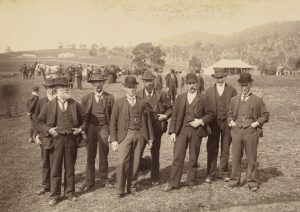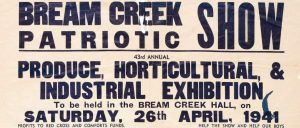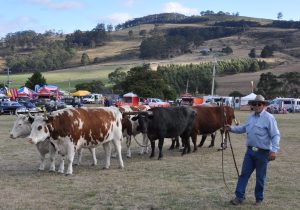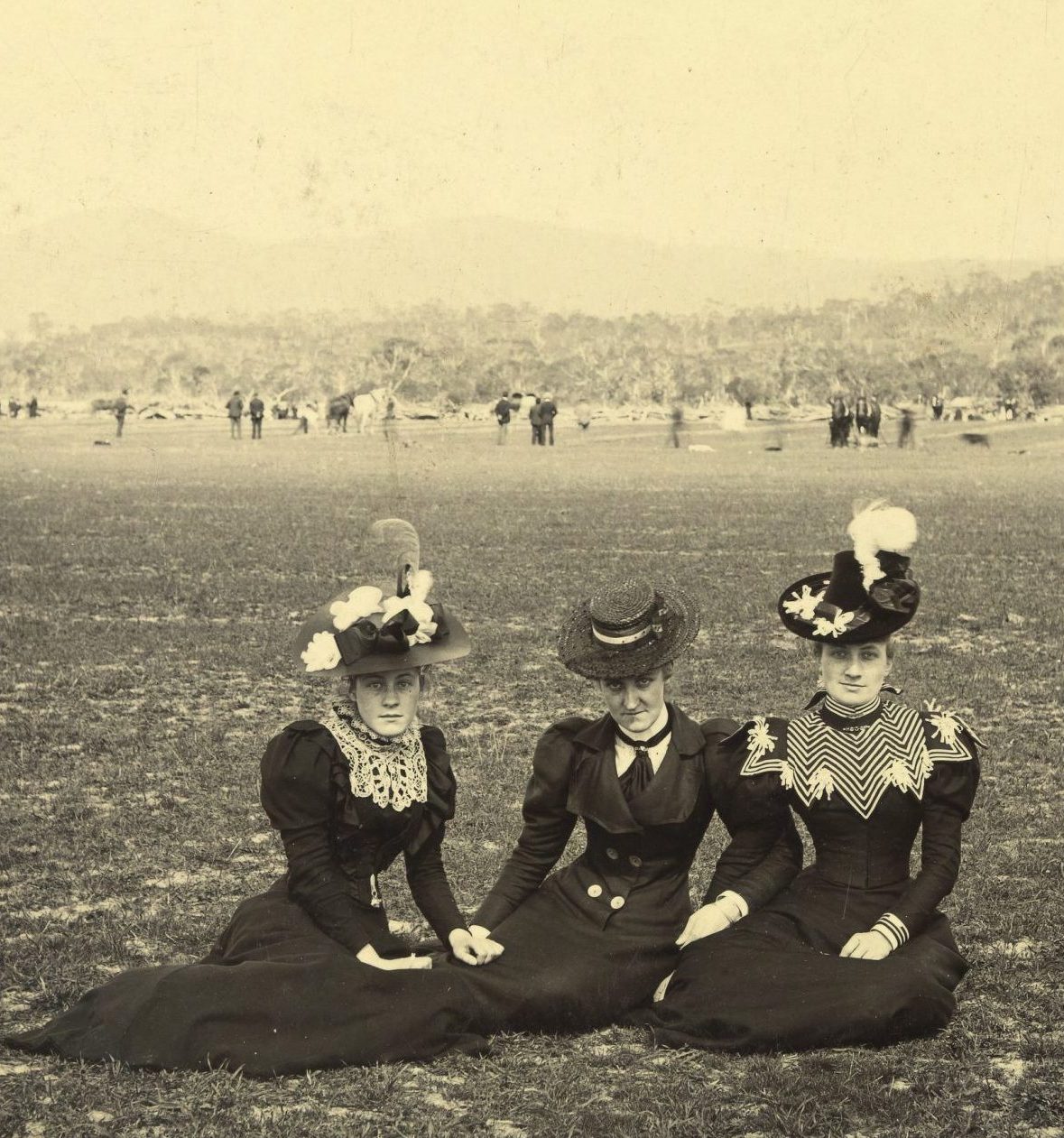The History of the Bream Creek Show: 1896 – the Present

The Bream Creek Show Society recently donated a collection of its posters from the 1930s to the 1950s to Libraries Tasmania. Whilst we already held some samples of Bream Creek posters, the donation by the Show committee means that we now have a solid and substantial record of this iconic rural event. With the 2020 Show one of the many public events cancelled in this particular historical moment, we are publishing this blog as a celebration of the Show’s long history – and look forward to its re-emergence in 2021.
The Place of the Show, the Show of a Place
Bream Creek is a township 50km east of Hobart, on the south-east coast of Tasmania. It is difficult to imagine any place that better represents Tasmanian rural life. The creek from which the township takes its name rises some 30km to the north, in the hilly forests inland from Cape Bernier, and winds its way down to Marion Bay. The black bream (Acanthopagrus butcheri) for which the creek was named are prized by commercial fishers as well as amateur anglers. The region is, however, best known for its annual agricultural show.
Agricultural shows have been a part of Tasmanian life since the early 1820s. The first agricultural show in Australia was organised in Hobart in 1822 by the Van Diemen’s Land Agricultural Society, forerunner of the Royal Agricultural Society of Tasmania. The Midland Agricultural Association was established in 1838. By the 1890s, when the Bream Creek Show was established, there were thirteen agricultural shows in Tasmania; another seven were established during the first half of the twentieth century.

The first Bream Creek Flower and Produce Show was held in May 1896, after a stalled attempt the previous year.
![A newspaper snippet. It reads: " Bream creek flower and produce show
[by our special reporter]
Monday last was by common consent voted the greatest re-letter day in the Bream Creek district since it has been settled. The gathering was identified with an inaugural show of farm and dairy produce, fruit and flowers, and carried through with great enthusiasm and success. The crowd of people was so great that they actually had to be admitted into the cricket pavilion (in which the show was held) in sections, whilst outside, on the cricket reserve, a trial of hunters, a race after a greasy pig, and other amusements were provided. The sermon in the Bream Creek district has been a fairly good one, and prices for all manner of produce having risen, the settlers and their families cam in hundreds, all well dressed, and looking prosperous and smiling. The weather was perfect.”](/wp-content/uploads/nla.news-page000000844068-nla.news-article9332984-L5-aa3a07e553e9134571cf0ff5ce6a5821-0001-e1583801138441.jpg)
By the 1920s, the Bream Creek Show was ‘one of the most popular annual country fixtures in Southern Tasmania’. During the First and Second World Wars, the Show served as a fundraiser for the Red Cross.

Although it was a relative latecomer to the scene, Bream Creek Show has proven one of the most enduringly popular agricultural shows nationwide. Despite the small size of the community (Bream Creek numbered only 124 residents in the 2016 Census), the Show routinely attracts crowds in the thousands. Data gathered by Kate Darian-Smith and Sarah Wills in the 1990s reveals that larger regional shows, in Queensland and Victoria in particular, attracted 20,000 or more, but Bream Creek’s 1997-98 attendance figure of 6,000 compared favourably with small-to-medium sized country shows, which typically attracted fewer than 10,000 (Agricultural shows in Australia, pp.31-52). More to the point, Bream Creek’s attendance figures have remained steady over the past twenty years, while many other rural shows have declined or collapsed completely.
The Bream Creek Show Today

The community of today’s Bream Creek has a different character than it did a century ago. As local historian Dez Vernon writes: ‘the district has become home to boat builders, furniture and crafts people as well as a variety of artists … Many people in the district now commute to Hobart to work’ (A country show, p.12). When it comes to the Show, though, Vernon observes that ‘There are no fast rides or fast foods and there are no sample bags to entice these crowds. So why do they come? Perhaps it is to experience the warmth, the simplicity, and sincerity of rural life’ (A country show, p.16).

So what is this ‘simplicity’? What actually is simple about boat building and furniture making? Or, indeed, managing a farm of any kind in this historical moment of rapid change? Shouldn’t we rather say that Bream Creek Show reflects how dynamic and complex Tasmanian rural life is today?
What’s in a Name?
As I’ve worked on this blog, I’ve become curious about that distinction between ‘show’ and ‘fair’. The two words are often used interchangeably. While Wikipedia regards ‘agricultural show’ as synonymous with ‘state fair’, there is a difference, and it’s one that lies in their history and what they have meant to their communities over time.
The British architectural historian David Braithwaite wrote that, ‘the atmosphere of today’s pleasure fair is far removed from the vigorous barter of primitive trading fairs’ (Fairground architecture, p.13). Australian agricultural shows like Bream Creek originated in the ‘cattle fairs and ploughing matches’ of early agricultural societies, which Darian-Smith and Wills note were ‘restricted associations which served the interests of the farming gentry’. These were serious professional meetings, not family fun days.
Over time, shows and fairs ‘became multi-faceted events featuring commercial, government and entertainment activities’ (Agricultural shows in Australia, p.15). The trade and commercial focus of Agfest and the educational objectives of the Royal Hobart Show ‘Schools and Community Day’ illustrate the very different directions and emphases that shows and fairs have taken.
The entertainment offered at shows has changed a great deal over time as well. Darian-Smith and Wills note the influence of sideshow operators on the scheduling of rural shows around the country: ‘in the late nineteenth century, many “showies” would follow this circuit by train and wagon, initially displaying their acts after the daytime agricultural and commercial activities as “night shows” … after the formation of the Showmen’s Guild of Australasia in 1909, sideshows became a more common feature of daytime activities’ (Agricultural shows in Australia, p.32).

Newspaper reports generally present the Bream Creek Show as an exhibition of local produce, but the evidence of the official posters and programs is that by the late 1940s it had become more carnivalesque. Beginning in 1946, through to at least 1956, the posters carried a notice: ‘Side shows – space available on application to the Secretary’. Newspaper reports from 1951 and 1954 confirm the presence of sideshows in those years. Up until 1993, maps of the Showground include a ‘Sideshow Alley’.

Since then, the official programs reveal an increasing focus on local crafts and rural industries.
Photographs taken by Cecil Percy Ray in the early twentieth century (NS392/1/393–NS392/1/399) capture the crowds at sideshow alleys in country shows around Tasmania. Freddy O’Grady’s Famous Athletic Troupe was a regular favourite. (O’Grady was ‘doing the shows’ around Australia at least as early as 1916).

Is it too fanciful to imagine that this photograph might have been taken at Bream Creek? There is no evidence of a sideshow alley there before 1946, but absence of evidence is not necessarily evidence of absence: for the period before the Second World War we are largely reliant on newspaper reports, and – even after 1950, when it is clear that the Show included other, fairground-style attractions – very few mention anything other than the judging of exhibits. The Pit of Mystery was on the showground circuit for several years, appearing at the Royal Hobart Show in 1911 and the Red Cross Carnival at Latrobe in 1915.
A ‘Pit of Mystery and Illusion’ also appeared at the Corowa Show in New South Wales in 1920. Sadly, none of these accounts reveals what was actually in the pit, nor precisely how Satan and all his subjects were outdone. As alluring as the Pit of Mystery may have been at the Hobart Show in 1911, the Tasmanian News reporter’s attention was instead captured by the ‘rather risky’ display of ‘snakes next door to a liquor booth’.
Now that, I think we can all agree, is authentic simplicity.
Acknowledgements
Grateful thanks to the Bream Creek Show Society, and to Judy Bennett and Des Vernon in particular, for their advice and assistance in preparing this article. All errors of fact and interpretation are of course my own.
Further reading
Libraries Tasmania’s holdings of Bream Creek posters, programs and other memorabilia
‘Four Bream Creek elders recall first Show’, Mercury 29 March 1954, p.9
The outdoor showman (Melbourne: Victorian Showmen’s Guild, 1947- ) *Not held by Libraries Tasmania
David Braithwaite, Fairground architecture (London: H. Evelyn, 1968)




